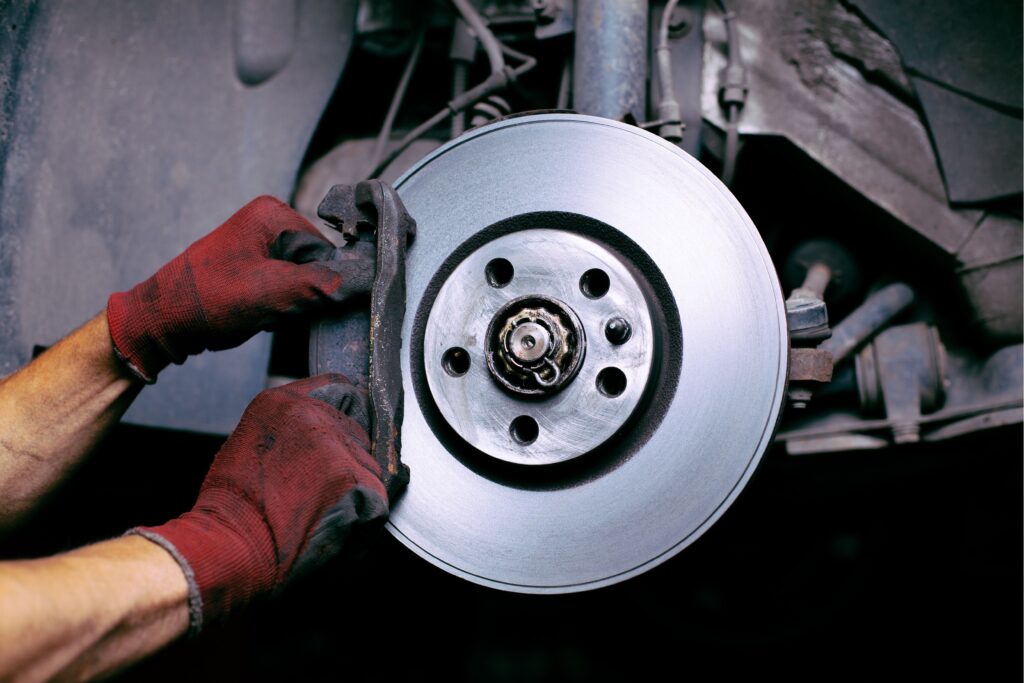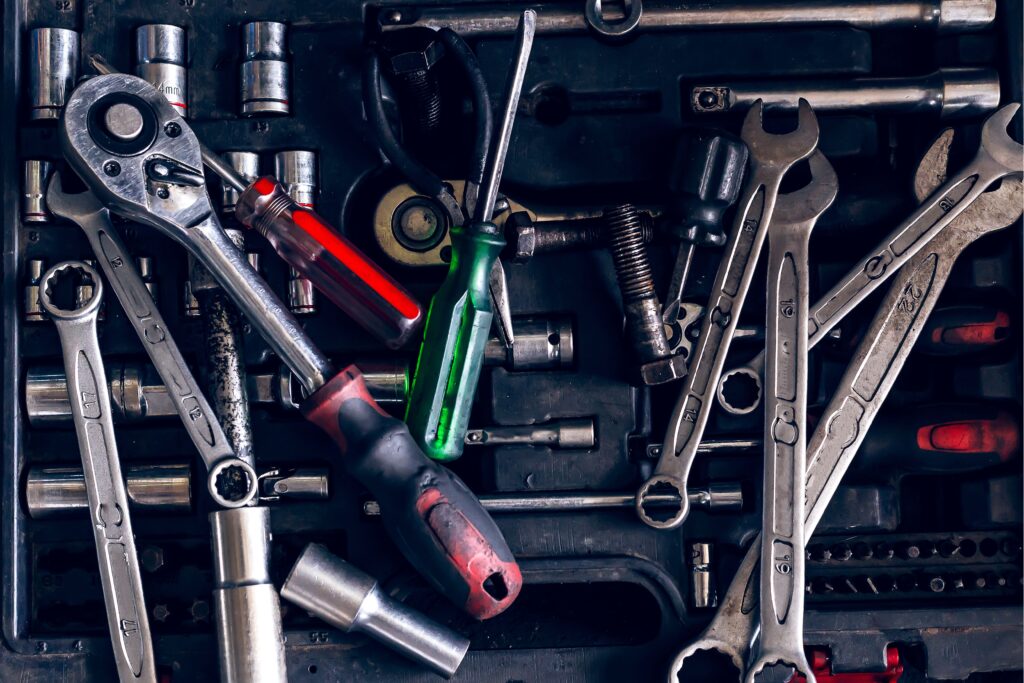In the bustling world of transportation and logistics, the role of trucks cannot be underestimated. These mighty machines carry goods across vast distances, ensuring the smooth functioning of supply chains.
However, like any mechanical device, trucks are prone to wear and tear. To maintain their optimal performance and prevent breakdowns that may disrupt operations, regular truck repairs are indispensable.
Importance of Truck Repairs

Trucks endure long hours on the road, battling rough terrains and unpredictable weather conditions. Over time, this constant strain can take a toll on various components, leading to malfunctions or failures that jeopardize not only the truck’s functionality but also the safety of its drivers and cargo.
Neglecting truck repairs can result in expensive repairs down the line or even catastrophic accidents. Moreover, efficient truck repairs also contribute to cost savings in terms of fuel consumption.
Faulty engines or transmission systems can cause trucks to consume more fuel than necessary. Identifying and rectifying such issues through timely repairs can significantly enhance fuel efficiency and reduce operational expenses.
Overview of Essential Tools for Truck Repairs

To tackle truck repairs effectively, it is imperative to have a well-equipped toolbox at your disposal. These tools enable mechanics or truck owners to diagnose issues accurately and perform necessary maintenance tasks efficiently.
Amongst the essential tools for truck repair is a comprehensive socket set. This versatile tool consists of various socket sizes and extensions that allow for hassle-free removal and tightening of nuts and bolts during repair work.
From engine components to suspension systems, a socket set ensures you have the right fit for every application. Wrenches are another vital component in any mechanic’s arsenal when it comes to working on truck repair.
Combination wrenches provide versatility with their open-end on one side and closed-end on the other – ideal for accessing tight spaces where bolts need turning. Adjustable wrenches come in handy when faced with odd-sized nuts or bolts, enabling a secure grip and torque application.
Torque wrenches allow for precise tightening to manufacturer specifications, ensuring optimal performance and safety. To handle screws of various types, screwdrivers are indispensable tools.
These handheld devices come in different varieties such as flathead, Phillips, and Torx screwdrivers. Each type corresponds to specific screw designs commonly found in trucks.
With a reliable set of screwdrivers, mechanics can effortlessly tighten or loosen these fasteners during repairs without causing any damage. Recognizing the importance of truck repairs is essential for maintaining the longevity and efficiency of these critical vehicles.
By investing in a comprehensive set of essential tools dedicated to truck repairs, owners and mechanics alike can tackle maintenance tasks with confidence and efficiency. In the following sections, we will delve into specific categories of tools that are indispensable for various types of truck repairs – from engine diagnostics to transmission issues and brake system maintenance.
General Tools for Truck Repairs

The Versatile Socket Set
When it comes to truck repairs, one tool that stands out as essential is the trusty socket set. This versatile tool allows you to effortlessly remove and tighten nuts and bolts in various applications. The socket set comprises a ratcheting handle along with a plethora of sockets that come in different sizes to accommodate diverse bolt heads.

From small hexagonal sockets to larger ones for heavy-duty applications, the socket set ensures you have the right tool at hand for every job. Moreover, socket sets often include extensions, which are invaluable when dealing with hard-to-reach areas when conducting truck repair.
These handy extensions allow you to access bolts hidden in tight spots without straining your muscles or contorting your body into uncomfortable positions. Whether it’s under the hood or beneath the chassis, having a range of sockets and extensions readily available in your toolbox can significantly expedite truck repairs.
Wrenches: Turning Torque into Action
Another indispensable category of tools when it comes to general truck repairs is wrenches. These tools are designed to turn objects by applying torque effectively and efficiently.
You’ll find three primary types of wrenches commonly used in truck repair work: combination wrenches, adjustable wrenches, and torque wrenches. Combination wrenches feature an open-ended jaw on one side and a closed or box-end on the other side.

This dual design allows you to tackle different bolt configurations swiftly and with precision. Adjustable wrenches, on the other hand, provide flexibility as they can adapt to various sizes by sliding their jaws accordingly—a convenient option when dealing with non-standard nut sizes.
For jobs that demand specific torque settings—such as engine components—a torque wrench becomes imperative. By accurately applying a predetermined amount of force during tightening, this specialized tool helps prevent over-tightening or under-tightening critical fasteners, ultimately ensuring the longevity and reliability of your truck.
Screwdrivers: The Unsung Heroes
While often taken for granted, screwdrivers play a vital role in any repair toolbox. When it comes to loosening or tightening screws during truck repairs, having a reliable set of screwdrivers is indispensable.
The three main types of screwdrivers you should have at your disposal are flathead, Phillips, and Torx. Flathead screwdrivers feature a single blade that fits into slotted screws—a classic design used in many applications.

On the other hand, Phillips screwdrivers have a cross-shaped tip that perfectly matches Phillips-head screws—a common type found in various truck components. Torx screwdrivers are necessary for working with specialized six-pointed star-shaped screws commonly found in electronic systems or some engine parts.
Having a comprehensive set of these three types of screwdrivers ensures you can tackle any type of fastening quickly and effectively during your truck repairs. Overall, these general tools—socket sets, wrenches, and screwdrivers—are the backbone of any truck repair task.
Their versatility and adaptability make them indispensable companions for both DIY enthusiasts and professional mechanics alike. By investing in quality tools and familiarizing yourself with their proper use, you’ll be equipped to handle an array of general repair needs efficiently while ensuring the smooth operation and reliability of your treasured truck.
Specialized Tools for Truck Repairs

Impact Wrench: Unleashing the Power to Tackle Stubborn Bolts
When it comes to tackling heavy-duty truck repairs, one tool in particular stands out as a true powerhouse – the impact wrench. Designed to provide a high torque output, this tool is an essential companion for any mechanic working on trucks.
Whether you are dealing with rusted bolts or tightly fastened nuts, an impact wrench can quickly and effortlessly remove them, saving you valuable time and effort. There are two main types of impact wrenches available on the market: air-powered and electric.

Air-powered impact wrenches are typically favored in professional settings due to their exceptional power and durability. They rely on compressed air to generate immense rotational force, making them ideal for heavy-duty applications.
On the other hand, electric impact wrenches offer the advantage of portability and convenience. They are battery-powered and do not require an air compressor for operation, making them suitable for mobile mechanics or DIY enthusiasts who may need to work in various locations.
Multimeter: Shedding Light on Electrical Mysteries
Electrical issues can be elusive and time-consuming to diagnose without proper tools. That’s where a multimeter comes into play – a versatile instrument that measures electrical current, voltage, and resistance within a truck’s electrical system. By using this invaluable device, mechanics can accurately pinpoint faulty components or connections that may be causing electrical malfunctions.

A multimeter typically consists of several essential functions: voltage measurement (both AC and DC), current measurement (in amps), resistance measurement (in ohms), continuity testing (to check if a circuit is complete), and diode testing (to determine if a diode is functioning properly). With these capabilities at their disposal, mechanics can troubleshoot various electrical issues found within truck systems such as lighting circuits, sensors, or the battery charging system.
Diagnostic Scanner: Unlocking the Secrets of the Onboard Computer

Modern trucks are equipped with sophisticated onboard computer systems that monitor and control various aspects of vehicle performance. When it comes to troubleshooting and identifying faults within these systems, a diagnostic scanner is an invaluable tool. This device connects directly to the truck’s onboard computer and retrieves valuable information in the form of fault codes and real-time data.
The diagnostic scanner enables mechanics to efficiently diagnose problems by reading error codes stored within the truck’s computer memory. These codes provide crucial insights into specific issues such as engine misfires, sensor malfunctions, or transmission faults.
By quickly identifying the root cause of a problem, mechanics can streamline their repair process, saving both time and money for themselves and their clients. In addition to reading error codes, some advanced diagnostic scanners also offer additional features such as data logging, live data monitoring, and even reprogramming capabilities for certain modules within the truck’s system.
These added functionalities empower mechanics to delve deeper into complex issues, allowing them to pinpoint elusive problems that may otherwise go undetected. With specialized tools like impact wrenches, multimeters, and diagnostic scanners at their disposal, professional mechanics can confidently tackle even the most challenging repairs on trucks.
These tools not only expedite repair processes but also enhance accuracy in diagnosing issues accurately. By harnessing their power and precision, mechanics ensure that trucks are back on the road swiftly while maintaining peak performance levels.
Engine Repair Tools
When it comes to truck repairs, the engine is undoubtedly one of the most critical components to focus on. To effectively diagnose and address issues within the engine, there are specific tools that every professional or DIY mechanic should have in their arsenal. These tools not only help measure the engine’s health but also enable the identification and resolution of underlying problems. In this section, we will discuss two indispensable tools for engine repair: the compression tester and fuel pressure gauge.
Compression Tester: Measuring Engine Health
The compression tester is a vital tool used to assess the overall health and performance of an engine by measuring its compression levels. By checking the compression in each cylinder, mechanics can identify any potential issues related to worn piston rings or valves that may need replacement. Using a compression tester involves removing all spark plugs from the cylinders and screwing in the tester into one spark plug hole at a time.

Once attached, you can crank over the engine using either an electric starter or manually if necessary. The gauge on the tester will display a reading that indicates how well each cylinder is maintaining pressure during combustion.
A low reading on a particular cylinder may suggest leakage due to worn piston rings, while inconsistent readings across cylinders could indicate valve problems. By pinpointing these issues early on, mechanics can efficiently plan repairs or replacements before more severe damage occurs.
Fuel Pressure Gauge: Diagnosing Fuel Delivery Problems
The fuel system plays a crucial role in ensuring optimal engine performance and efficiency. A fuel pressure gauge is an essential tool utilized for diagnosing potential fuel delivery problems that might arise within a truck’s system. To use a fuel pressure gauge effectively, it must be connected to either a test port on the fuel rail or inline with the fuel line itself.
Once connected, the gauge will display the pressure levels at which fuel is being delivered to the engine. This information helps mechanics determine if the fuel system is functioning correctly or if there are any issues that may be affecting performance.

For example, a low-pressure reading could indicate clogged fuel filters or a faulty fuel pump. By diagnosing such problems accurately, mechanics can take necessary actions such as cleaning or replacing filters, or repairing the fuel pump to restore proper fuel delivery and optimize engine performance.
Engine repairs require specialized tools that allow for accurate diagnosis and timely resolution of problems. The compression tester assists in evaluating an engine’s overall health by measuring cylinder pressure, helping identify worn piston rings or valves.
A fuel pressure gauge assesses the efficiency of the truck’s fuel system by measuring pressure levels and assisting in diagnosing potential delivery issues caused by clogs or faulty components. These tools are indispensable for any mechanic looking to maintain and repair truck engines efficiently.
Transmission Repair Tools
Transmission Jack
A transmission jack is a specialized tool designed specifically for supporting heavy transmissions during removal or installation processes. It plays a crucial role in easing the task of working underneath the vehicle safely, providing stability and support where it is needed most.
One of the main advantages of using a transmission jack is its ability to handle the weight and size of a transmission unit. Transmissions can be incredibly heavy and cumbersome, making them difficult to maneuver without proper support. A transmission jack typically features an adjustable height and tilt mechanism, allowing technicians to align it perfectly with the vehicle’s transmission housing.
The design of a transmission jack includes several key components for efficient operation. These usually include sturdy steel construction, swivel casters for easy mobility, and a cradle or saddle that securely holds the transmission in place.
Additionally, many models come equipped with safety chains or straps that further enhance stability during lifting and positioning. When it comes to removing or installing transmissions, safety is paramount. Using an appropriate transmission jack significantly reduces the risk of injuries that may occur due to mishandling or dropping heavy components.
By providing stable support at various angles and heights, technicians can work comfortably beneath the vehicle without compromising their safety or causing damage to other parts of the vehicle. A transmission jack is an essential tool for any truck repair shop or individual working on transmissions regularly.
Its robust construction, adjustable features, and added safety measures make it invaluable when dealing with these vital components. By investing in a quality transmission jack, technicians can enhance their efficiency while ensuring their own well-being during complex repairs involving transmissions.
Safety Considerations

When using a transmission jack for truck repairs, there are some important safety considerations to keep in mind: 1. Always follow manufacturer instructions: Each brand/model may have specific guidelines on weight limits, proper usage techniques, and maintenance requirements.
Read the manual thoroughly and adhere to all recommendations. 2. Ensure stability: Before lifting a transmission, ensure that the vehicle is parked on a level surface and the jack’s casters are locked securely.
Double-check that the transmission unit is correctly positioned on the jack’s cradle or saddle. 3. Use safety straps or chains: When lifting the transmission, utilize any included safety straps or chains to further secure it in place.
This minimizes the risk of it slipping or falling off during transportation. 4. Don’t exceed weight limits: Every transmission jack has a maximum weight capacity; exceeding this limit can lead to equipment failure, accidents, or injuries.
Always confirm that your chosen jack can handle the weight of the specific transmission you are working with. 5. Work in pairs if needed: In cases where heavy transmissions need to be removed or installed, having an extra pair of hands can greatly improve safety and ease of handling.
If possible, enlist a coworker for assistance during these tasks. By adhering to these safety considerations and using a reliable transmission jack properly, technicians can ensure their own well-being while performing efficient and effective repairs on truck transmissions.
A Brake Bleeder Kit

The brake system is one of the most critical components of any truck, ensuring safe and efficient stopping power. When it comes to repairing or maintaining the brakes, a brake bleeder kit is an indispensable tool. This kit allows for the proper bleeding of the brake system, removing air bubbles that can compromise brake performance.
A brake bleeder kit typically consists of a hand pump, tubing, and a collection bottle. To use this tool effectively, start by locating the brake caliper or wheel cylinder with the bleed valve.
Attach one end of the tubing to the bleed valve and immerse the other end in the collection bottle filled with brake fluid. To bleed the brakes, pump the handle on the hand pump to create a vacuum within the system.
As you loosen the bleed valve with an appropriate wrench, air and old fluid will be expelled into the collection bottle. Continuously pump until no more bubbles are visible in the tubing and only clean fluid flows out.
Using a brake bleeder kit ensures that any trapped air within your truck’s braking system is removed completely. This process helps maintain optimal braking performance by preventing spongy brakes or long pedal travel that could compromise your safety on the road.
Conclusion
Having access to essential tools for truck repairs is crucial for any responsible truck owner or mechanic. Whether it’s general tools like socket sets, wrenches, and screwdrivers or specialized tools such as impact wrenches, multimeters, and diagnostic scanners – each tool plays a vital role in ensuring efficient repairs. By investing in these tools and regularly maintaining them in good condition, you can save both time and money down the road.
These tools empower you to diagnose issues accurately and perform repairs effectively without relying solely on professional mechanics. So embrace your inner handyman (or woman) and equip yourself with the necessary tools to tackle truck repairs confidently.
Remember, a well-maintained truck is not only safer for you but also contributes to a more efficient and reliable transportation system overall. Get your toolbox ready, and let the journey towards hassle-free truck repairs begin!










